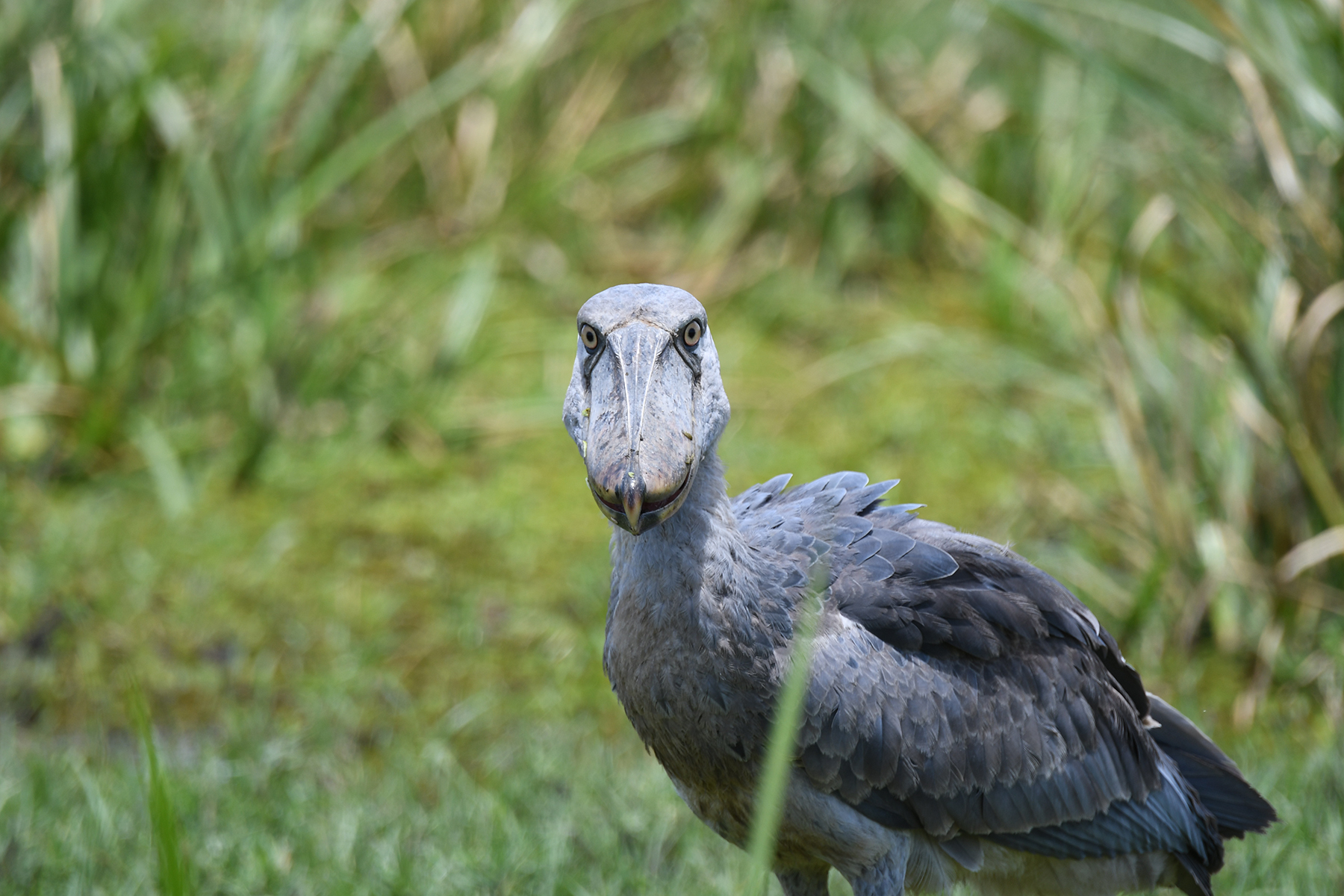

In Uganda, one of the most famous destinations for shoebill birding safaris is Mabamba baylocated on the western side of Entebbe on the shore of lake Victoria. These fascinating birds are found in swampy areas with fresh water characterized with thick papyrus plants, water lilies and other grass common in fresh water swamps. It may therefore not be easy to spot them just anywhere but chances are normally higher when on a Uganda birding safari to specific spots that we recommend. Although shoebills can live for as many years as 45 and above, they are a critically endangered species of birds, there are about 1000 shoebills left in Uganda. The name of the shoebill stork was derived from its shoe-shaped bill which also gives it a large head hence being referred to as a “King whale-head”. Shoebill Uganda – The exclusive shoebill stork is one of the rare to see birds in Africa and is one of the famous birds of Uganda to look out for on your Uganda safari. 5 Days Luxury Gorilla and Wildlife Safari.5 Days Gorillas and Wildlife from Kigali.3 Days Kibale and Queen Elizabeth Safari.How Your Trek Saves the Mountain Gorillas.What is a Gorilla Habituation Experience.What to expect on your Uganda Gorilla Trek.Where are the Mountain Gorillas in Uganda?.How To Acquire A Gorilla Trekking Permit.Best Time To Go Gorilla Trekking in Uganda.6 Days Gorillas and Murchison Falls Safari.5 Days Gorillas and White water rafting.Let’s hope the efforts will help the Shoebills grow in number.īecause it would be a shame to have this beautiful, dorky dinosaur go extinct. Local fishermen in canoes look after the Shoebills to protect them from poachers.Ĭonservation plans are put in place to protect the real-life Big Bird.

Their numbers are dropping and there are only 3000–5000 mature shoebills left on planet earth. They flee at the slightest disturbance of their habitat, leaving their nests, eggs, and chicks behind.īirdLife International and the International Union for Conservation of Nature (IUCN) classify Shoebills as Vulnerable to Extinction. The expanding kind, besides the poachers.ĭespite their fierce appearance, Shoebills are shy birds. Their distinct look makes them an interesting target for poachers, who snatch Shoebill eggs and chicks like hawks and sell them to wealthy bird enthusiasts.ĭroughts, fires, and humans. No matter where you stand, dorky muppet bird, or scary modern-day dinosaur, Shoebills are fascinating birds we should protect. When all has evaporated, it leaves a chalky substance behind which helps the Shoebill to protect its legs from the scorching African sun. The pee evaporates and cools the bird down, helping it to regulate its body temperature.

Their “pee” is a mixture of urine and feces which coat their legs. Urohidrosis is not unusual in the bird world. Staring contest in 3,2,1… Photo by Kumiko on Flickr They defecate on their legs to cool themselves down. Just imagine this Shoebill, staring you down for hours straight. You’d either end up laughing or give up when you’re starting to feel unsettled. Its eagle-like eyes and motionless posture, combined with a pelican beak and Big Bird-like hairdo, make this one tough staring contest. It will stare at the water for hours, rarely blinking, waiting for the right meal to swim by. If there’s one skill a Shoebill is exceptional at, it’s staring. It would defeat you in a staring contest. And the strongest one gets fed and survives.

The weaker chick either gets killed by its sibling or gets ignored by its mother. Mother Shoebill is wise and knows which chick is more likely to survive in the wild. The stronger baby Shoebill can attack its weaker sibling to be the only one who gets fed. There might be a sinister and slightly sad reason for that. On average, the Shoebill mother lays 2 eggs. Shoebill siblings don’t seem to get along very well. It will easily scoop up and gulp down lungfish, eels, snakes, and even baby crocodiles. It has a wide beak that resembles a typical Dutch klomp, with a sharp hook that it uses to hunt big fish and reptiles.Īs if the Shoebill’s death stare wasn’t scary enough, it stands still like a statue for hours, quietly waiting to snatch its next meal. They spend their time wading in the swamps of the Great Lakes region of Africa. Luckily, these impressive whale-heads live solitary lives, far away from us. Photo by Pelican on Flickr Draining the swamp, one baby crocodile at a time.


 0 kommentar(er)
0 kommentar(er)
